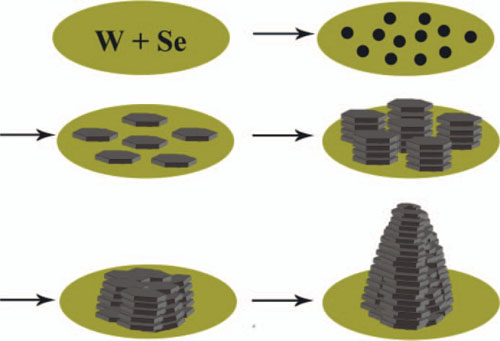Transition-metal dichalcogenide WSe2, with a layer structure similar to graphite, has drawn considerable attention due to its promising applications in many fields. Many efforts have been devoted to the design and preparation of WSe2 with different morphologies. However, the existing methods involved either the use or generation of expensive and toxic starting materials such as WCl4, W(CO)6, para-xylene, and H2Se or the formation of the products obtained with varying diameters. It remains a great challenge to develop facile and efficient methods to satisfy the need for scalable preparation of WSe2 with controlled size and morphology.
 |
| Schematic drawings of the formation of tower-like arrays containing ultra-thin WSe2nanosheets. |
Researchers at State Key Laboratory of Solid Lubrication, Lanzhou Institute of Chemical Physics (LICP), Chinese Academy of Sciences (CAS), have synthesized tower-like arrays of ultra-thin hexagonalWSe2 nanosheets by a high-temperature solid-state reaction of W and Se with the aid of graphite. As-obtained WSe2 nanosheets were uniformly 10 nm thick and 100 nm in diameter, far below submicrometer WSe2 sheets (250 nm thick and 1–3 μm in diameter) prepared in the absence of graphite. Lamellar graphite plays a critical role during the transformation of submicrometer sheets into ultra-thin nanosheets with a controlled assembly structure. In addition, the friction and wear test results indicated that as-fabricated product is an excellent lubricating material used as an additive to markedly improve the friction reduction and antiwear properties of base oil paraffin. Therefore, the process provided a simple and cost-effective strategy for the fabrication and tribological application of other lamellar transition metal dichalcogenides with a uniform small size and controlled morphology.
The work has received support from the Open Project of the State Key Laboratory of Solid Lubrication of LICP and the Jiangsu Provincial Natural Science Foundation of China. The findings have been published in Tribology Transactions(Tribology Transactions, 55: 297-301, 2012).


